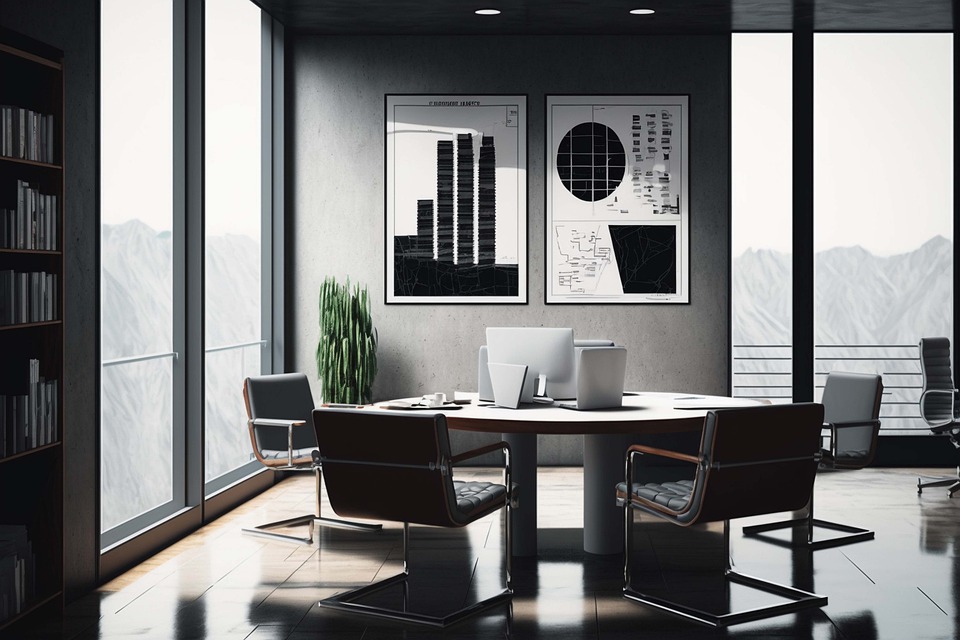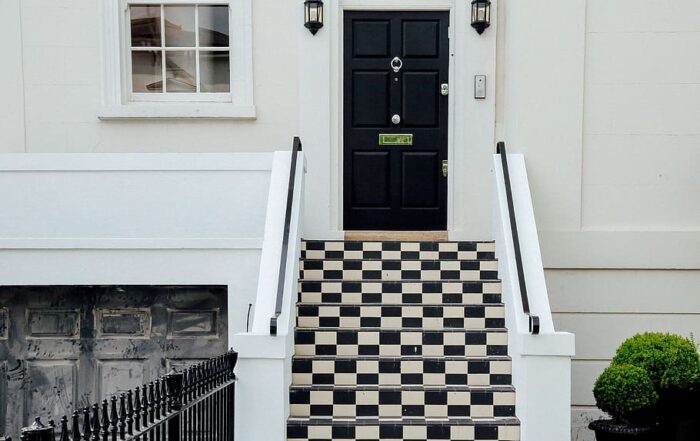
Creating Better Workspaces With Smart Office Buildings
Date Posted:
June 2, 2023
Share This:
The phrase “smart office buildings” might conjure images of cities full of dazzling chrome skyscrapers and moving walkways. Well, some of those pseudo-futuristic visions are true. But a smart office building involves much more than biometric retinal scanners and Matrixesque aesthetics.
With a global market size that should reach over $66 billion by 2027, smart offices are here to stay. They make workspaces more enjoyable, hygienic, interactive and productive. When people and smart buildings can communicate virtually to ease workflows, you’re bound to please employees and even save money.
So, how do you better your workspace and boost employee satisfaction with smart office automation? We’ll look at two main categories: building-based tech (the structure itself) and people-centric tech (like media services and devices). But first, exactly what is a smart office?
[Related: 20 Conference Room Ideas and Trends for 2023]
What Is a Smart Office?
This is a fairly straightforward definition with hundreds of facets. A smart office is a building or workspace that contains Internet of Things (IoT) technology, which streamlines and automates tasks. In other words, smart office buildings are office buildings with integrated smart tech.
And the sky’s the limit concerning what technologies companies can use in smart office buildings. The key is using people-focused smart tech that connects and simplifies work-related actions, from the complex to the mundane.
For example, where employees once swiped a card to enter a building, they might use a touch-free smartphone scanner. (A solid alternative is an antimicrobial fingerprint scanner.) Connected building software then logs that those employees are present.
When they enter their workspaces, smart lighting and climate systems adjust per their preferences. Personal tech, like computers and audiovisual (AV) devices, synchronize and load content perfectly. They might open a companywide app to reserve conference rooms, prime presentation tech and send reminders.
And when the workday is over, they can readjust all those systems and devices to cost-saving levels from one hub.
In fact, companies were adopting smart technology fairly steadily (albeit slowly), but demand boomed after COVID hit. As the chaos began to subside, the benefits of smart office buildings beyond distancing and hygiene became apparent. Employees want the same comfortable, customized experience that they enjoyed while working remotely, and smart offices provide it.
In today’s omnipresent workplace — whether in-person, hybrid or remote — smart offices create more dynamic, all-around pleasant spaces.
Pro tip: Deloitte offers a fantastic overview of smart buildings that also applies to smart office buildings. It’s certainly worth a read if you’re new to the concept and want to learn more.
[Related: Digital Wayfinding Signage: Everything You Need To Know]
Structure-Based Smart Office Building Features
Here, we’ll look at the IoT tech that goes into smart office buildings as structures. Employees generally can control settings, and some tech adjusts automatically. It’s so integrated that it becomes part of a natural, frictionless flow — and that’s fantastic for employee satisfaction.
Smart building features usually share the following IoT tech:
- Motion, pressure, temperature and light sensors
- Touch-free access and control (via apps, smart speakers and more)
- Wi-Fi and Bluetooth connectivity (for cloud communication, storage and data synchronization)
And these aren’t disparate parts! With networking, integrated room control and centralized distribution, you get a sweeping overview of and instant access to all aspects of smart office technology.
[Related: Why You Should Work With a Contractor and Architect Early on in Your AV Project]
Entry and Surveillance Systems
Security and surveillance are concerns at all offices, and smart offices provide both.
IoT keypads, scanners and/or codes are a few options to identify and track employees. They don’t have to futz with lanyards and lost cards (you’re unlikely to leave your fingerprint at home). The most difficult task might be remembering a personal passcode at the entrance!
Meanwhile, smart surveillance offers around-the-clock monitoring. Yes, it might sound slightly dystopian, but preventing theft and physical threats is the primary goal.
For example, most supervisors in a smart office building won’t note (or care) what employees do during downtime. But if someone tries to enter the building unlawfully or with ill intent, real-time video, audio and data records exist. In a worst-case scenario, responders can arrive quickly while receiving instant status updates.
And ultimately, employees feel safer at work with smart office security systems.
Heating, Cooling and Circulation Systems
Smart HVAC systems are some of the very best smart office building features.
First, smart climate control systems are invaluable for both employee comfort and overall cost savings. With customizable settings and remote access (with the right creds), smart offices use smart thermostats to keep temperatures steady. And it’s certainly not one building-wide setting — “zoning” allows for distinct temperatures in each room or area.
Additionally, in-office work has become much more cautious in the COVID era (and rightly so). To help fix the issue, smart ventilation and circulation systems pair with smart thermostats. Together, filtering and purifying air are automatic processes that curb viral and bacterial spread.
Other smart ventilation and climate control benefits include air quality monitoring — a massive step toward creating a healthier workplace.
As a result, smart office buildings boost comfort, convenience and health while cutting costs and saving energy.
Lighting and Shading Systems
Smart lighting systems are an integral part of smart office automation. Why? Because lighting affects mood, and mood affects productivity. (You can see where we’re headed.)
With apps, voice commands, handheld remotes and more, employees can tweak light levels to create their ideal atmosphere. Tackling daily tasks instantly becomes easier. But smart office building lighting is far more sweeping than room-by-room settings.
For example, you might set smart lighting systems to sense motion and brighten gradually (and nix headache-inducing fluorescent lights). Then, you might program lights to dim incrementally before a conference room presentation. Design and placement possibilities are practically countless, from LED desk lamps to recessed RGB ceiling panels.
Plus, you save money on building-wide utilities because smart lights are innately energy efficient. IoT devices work together to cut costs, too. For example, if a room empties, sensors can communicate that to the room’s smart lights, which power down.
And when you’d like to truly elevate lighting control (and cost savings) in a smart office building, add motorized window treatments. These quiet, battery-operated window coverings are stylish, let in mood-boosting natural light when desired and offer diverse controls.
By regulating how much outdoor heat or cool you’d like to allow in, you also enhance smart climate control. Overall, motorized shades present the best of both climate and lighting worlds — and in an array of chic models.
[Related: Why We Love Lutron Shading Systems]
People-Centric Smart Office Technology
Now, let’s look at what employees (and everyone else) use to make work simple in a smart office building. After all, smart office technology should make the workday both intuitive and satisfying.
With features like integrated room control, you can adjust both structure- and people-centric smart office technology. All you need are networking and centralized distribution for seamless smart office automation.
Plus, people-centric smart office technology streamlines how you move between your home office and your office building. With features like paired devices, connected systems and cloud storage, taking that deck you crafted from home and presenting it in a smart conference room are easy. You might even fine-tune your smart office thermostat from your home office when the weather unexpectedly shifts, and vice versa.
[Related: Smart Voice Control Features That Simplify Your Daily Life]
Digital Media Systems
Today’s smart office wouldn’t be too useful without the ability to share content in a snap. With a smart digital media setup, you and your colleagues get lightning-fast loading via paired devices. And of course, all content is razor-sharp and in high definition!
For example, you (or an employee) connect a smart device to a networked digital media center. This is usually a touchscreen panel that syncs and organizes the media you want to share. From interviews to bustling brainstorming sessions, all formats shine with AV clarity.
And that fits flawlessly in a smart office environment. What throws a wrench in the works like fuzzy or missing content? (If you’re in sales, you know it’s a major embarrassment when pitching to potential clients.)
Presentation Technology Systems
IoT smart office technology doesn’t leave those aforementioned important presentations to chance. Well, maybe you’re simply holding a standard employee check-in — you still want it to go without a hitch.
With smart presentation technology, you pair a smartphone, smart TV or streaming device with an automated AV presentation system. This creates top-notch AV displays on a broad projection screen. Smart office technology settings even let you pre-program presentations so streaming content and connections don’t trail off or overlap.
This type of people-centric tech takes smart office automation and elevates it to an ultra-professional level. Whether you’re speaking with employees or wooing a client, they’ll clearly see and hear each image and word.
Pro tip: At AV Smart Solutions, we often opt for smart projectors, Apple TVs, Roku sticks and surround-sound Sonos speakers. They’re not just dazzling devices — they offer tons of flexibility for future smart add-ons and updates.
Videoconference and Telepresence Systems
In smart offices juggling in-person, hybrid and remote work, conferencing is constant. And honestly, it can be a pain without the right setup. Smart videoconferencing systems cure those seemingly unavoidable hiccups while delivering top-tier AV quality.
And it gets better — like most IoT tech, videoconferencing systems work with structure-based tech, like lighting control. For example, you can walk into a prebooked conference room, have the lights dim and begin a Zoom conference with a tap. You might even use your climate control app beforehand to drop the room’s temperature by a few degrees.
With artfully placed HD TVs or projection screens, smart speakers/soundbars and HD cameras, you can make smart office automation flawless. (And you definitely showcase your professional chops during any virtual conference.)
Pro tip: We like using Neat Bars with Crestron conference systems. Together, they make videoconferencing feel like a face-to-face roundtable discussion. When you group cutting-edge videoconferencing, digital media and presentation systems, smart office meetings are unfailingly crisp and clear.
[Related: What To Look for in AV Installation Companies]
Embrace Smart Office Automation With AV Smart Solutions
At AV Smart Solutions, we specialize in crafting office environments for peak comfort and efficiency. Alongside our expertise in the residential and commercial sectors, we’re ready to prime your workspace with smart technology.
We ease your mind and offer comprehensive services, from tech advice to fast, full-scale installation. Additionally, we work with your office décor to ensure all remains as it should be — but better. Get ready for happier employees, an ideal workplace and long-term cost savings!
When you’re ready to build or equip a smart office building, please get in touch. Call us at (425) 655-5052 or complete our inquiry form for a free consultation. One of our specialists will contact you promptly.
Featured image via Pixabay


